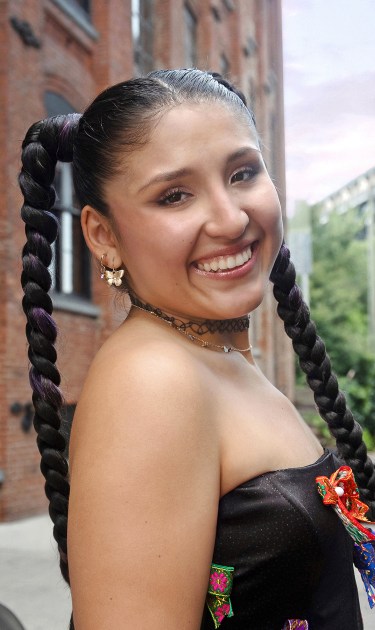When Milena Warthon decided to compete at Chile’s traditional Festival Viña del Mar in 2023 with “Warmisitay,” she didn’t expect that so many people would resonate with it. “This is a song about an Andean woman who celebrates herself and feels beautiful during the Carnival,” she tells Remezcla. The song’s name is the quechuañol term meaning “mi mujercita,” or my little woman, and was inspired by the experiences of Warthon’s grandmother Teresa in Peru’s carnival Puka Polleracha (quechua word for “pollerita roja”). “So I went [to the Festival] with my pollerita, and when I sang this song, many people identified with it — not only people from Peru but also the audience in Chile,” she adds. By winning the crown over, Warthon got first place in the Festival’s Folklore category. But perhaps more importantly, she learned how much she identified with it herself.
As a Gen Z singer who grew up listening to foreign pop music in Lima, life in the Andes was not a part of Warthon’s reality, even though her family had told her all about it. However, singing about her family’s stories was a way to connect with her background. “I’m super pop, but I come from Andean roots, and that’s in my face, in my features, everything. In ‘Warmisitay,’ I sing about my grandmother, but that warmisitay could also be myself,” she says.
Now, she has a clear mission — to share the Andean and Peruvian cultures with the world through her unique genre: pop andino. Coined by the 24-year-old, pop andino mixes pop music with traditional Andean rhythms and instruments. “Pop andino is more than a genre – it’s a way to express my cultural identity, but also everything that I like,” she says.
Warthon’s triumphant participation at Viña del Mar starkly contrasted with what she experienced during her time at La Voz Peru in 2021. What was celebrated at the Chilean event is what was attacked on the competition show. “Many people say I don’t have the profile of a pop artist,” she shares. Warthon received many hate comments online, mocking her music choices or appearance. “Everything I always wanted to do was seen as foolish or an impossible dream. But now I am being a part of a change,” the singer declares.

At the time, she was still searching for her unique sonic identity. During the show, she caught attention with her cover of Reik, Ozuna, and Wisin’s “Me Niego,” whose arrangements included Andean flutes. Warthon also released a video of the cover, inspired by caporal, a traditional dance style found in Peru, Bolivia, Ecuador, and Colombia — “el reggaeton de los Andes,” as she describes. “Since then, I started studying the genre to find ways to make it more like myself. It has been an interesting journey to implement certain symbols of my culture [in my music] so I wouldn’t feel like they [have to be] set apart from my pop identity,” she adds.
Having found her uniqueness, the combination of Peru’s indigenous heritage and pop culture aesthetics is heard and seen in Warthon’s songs and music videos. “Maravilloso” blends the contemporary beat of reggaeton with a strong message about the wonders that Peru has to offer. “Sometimes you have to get a pop beat with lyrics that lean towards folklore [and sometimes it’s the opposite]. That’s what I did with ‘Maravilloso,’” she says about the first song she wrote for her album Pop Andino (2023). “Most importantly, what I want to highlight is not only how Peru has wonderful culture, food, and landscapes, but also wonderful people. We are very hardworking people, and it’s through people’s work, art, and orality that the culture is transmitted.”
Such oral stories inform several of Warthon’s songs — take “Ojos Negros” as an example. The track is based on the story of the Yungai avalanche in 1970, which took Warthon’s great-grandparents’ lives. “When people migrate from the Andes [to bigger cities], part of their culture may get lost. But my family has told me everything. I did not live in the Andes, but my parents, grandparents, uncles, and aunts brought the Andes to me,” Warthon notes.

Some of these stories are also about discrimination and suffering. “Wearing polleras or braids used to be badly seen,” she explains about the symbols of Andean culture and women. “When you saw a woman wearing it, you would know it was an Andean woman, and this was a reason to discriminate against them. But now I acknowledge and embrace the pollera — even though mine does not look much like the traditional ones because I add my own touch to it. I also feel beautiful when I celebrate my culture, despite any beauty stereotypes that exist in the world.”
I acknowledge and embrace the pollera… I also feel beautiful when I celebrate my culture, despite any beauty stereotypes that exist in the world.
Warthon is leading a change that can also represent something bigger for her country’s music industry. She describes the pop market in Peru as one “that’s still in diapers.” “Peruvians consume a lot of local music, such as cumbia and salsa, but when it comes to pop, rock, or reggaeton, the music that is popular here is mostly from foreign artists,” she explains.
In a recent TikTok video, Warthon addressed Peruvian people’s claims that the country does not have its own representative among the Latine worldwide icons like Karol G or Shakira. Perhaps the closest Peru has ever had to an international music star is Rossy War. Known as “the queen of tecnocumbia,” War’s hits “Nunca pensé llorar” and “Tonto” are classics not only in Peru, but also in Ecuador and Brazil. “I’m certain that Peruvians are not aware of how famous Rossy War is abroad,” she notes. Warthon met War at a festival in 2021, and to this day, she says she’s fond of her not only for her artistic legacy but also for her kindness towards younger talents.

But Warthon’s challenges of becoming an international star are a little different. “To grow alone is harder. In reggaeton, there are features and artists collaborating with each other, which makes the industry grow for everyone. But to Peru, my project is a little more disruptive. Thankfully, I have [conquered] my audience, which consumes my music and allows me to keep the wheel turning. But it’s an expensive dream,” Warthon says. “To pop artists, the visuals and the outfits are almost as important as the sound, so I invest a lot in videos, fashion, choreographies, and performances.” The amount of thought Warthon puts into her outfit choices led her to create her own fashion brand. Its name? Of course, Pop Andino.
When asked if she intends to be a Peruvian pop star acknowledged worldwide, Warthon says it is her dream that her music takes her as far as possible. It’s a dream she is steadily turning into reality — one song, one performance, and one pollera at a time. And as she does that, it’s not her voice alone that is being projected to the world. “In my voice, I have the voice and fight of all my ancestors,” she proclaims.




